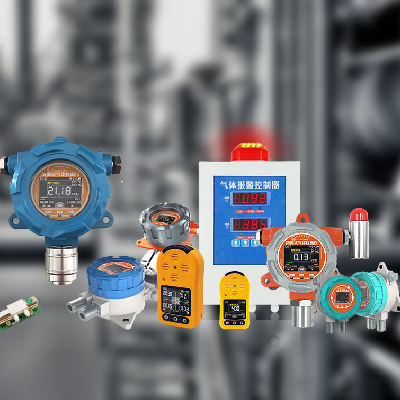Gas sensor Introduction
Gas sensors are vital components detect the presence of various gases in the surrounding environment. These sensors play a critical role in ensuring safety, environmental monitoring, industrial processes, and indoor air quality management. Gas sensors are detect specific gases, such as carbon monoxide, methane, hydrogen, ammonia, and various volatile organic compounds, and provide valuable data for a wide range of applications.Let’s talk about the specific types of gas sensors.
Type of Gas sensors
1. Semiconductor gas sensors

It is made by using the principle that the electrical conductivity of some metal oxide semiconductor materials changes with the composition of the ambient gas at a certain temperature. Semiconductor gas sensor can be effectively used for: methane, ethane, propane, butane, alcohol, formaldehyde, carbon monoxide, carbon dioxide, ethylene, acetylene, vinyl chloride, styrene, acrylic acid, hydrogen sulfide and ammonia (including amines, hydrazine) and many other gases to detect.
The main suppliers of such sensors are currently in Japan (the inventor), followed by China and, more recently, South Korea. There is also considerable work in other countries such as the United States.
2. Catalytic combustion gas sensors

This gas sensor is to prepare a high temperature resistant catalyst layer on the surface of platinum resistance. At a certain temperature, combustible gas catalyzed combustion on its surface. Combustion is the rise of platinum resistance temperature, resistance change, change value is a function of combustible gas concentration. At present, the main suppliers of this sensor are in China, Japan and the UK (country of invention)! China is currently the largest user of such sensors (coal mines) and has the best sensor production technology, leading manufacturers of catalytic combustion gas sensors
3.Thermal conductivity pool type gas sensor
Each gas has its own specific thermal conductivity. When the thermal conductivity of two or more gases is greatly different, the thermal conductivity element can be used to distinguish the content of one component. This sensor is used for hydrogen detection, carbon dioxide detection, high concentrations of methane detection. It’s an old fashioned product with manufacturers all over the world. Product quality is similar all over the world.
4. Electrochemical gas sensor
It has electrochemical activity for quite a part of flammable, toxic and harmful gases, and can be electrochemical oxidation or reduction. Using these reactions, the composition and concentration of gas can be distinguished. There are many subcategories of electrochemical gas sensors:

(1) galvanic gas sensor (also known as: Gavonni battery gas sensor, also known as fuel cell gas sensor, also known as spontaneous cell gas sensor), their principle line with the dry cell we use. This sensor can effectively detect oxygen, sulfur dioxide, chlorine gas and so on.
(2) Constant potential electrolytic cell type gas sensor, this sensor is very effective for detecting reducing gas, its principle is not the same as the galvanic cell sensor, its electrochemical reaction is under current force, is a real Coulomb analysis of the sensor. This sensor has been successfully used in the detection of carbon monoxide, hydrogen sulfide, hydrogen, ammonia, hydrazine, and other gases, and is currently the mainstream sensor for toxic and harmful gas detection.
(3) Concentration cell type gas sensors, the gas with electrochemical activity on both sides of the electrochemical cell, will spontaneously form concentration electromotive force, electromotive force size is related to the concentration of gas, the successful example of this sensor is automobile oxygen sensor, solid electrolyte type carbon dioxide sensor.
(4) limit current type gas sensor, there is a measurement of oxygen concentration sensor using the electrochemical pool limit current and carrier concentration related to the principle of oxygen (gas) concentration sensor, used for automobile oxygen detection, and oxygen concentration detection in molten steel.
China is an early starter in this field. Chinese IoT manufacturers have large volumes and good quality, which makes them suitable for procurement.
5. Infrared gas sensor
Most gases have characteristic absorption peaks in the mid-infrared region, and the concentration of a gas can be determined by detecting the absorption at the position of characteristic absorption peaks. Such sensors used to be large analytical instruments, but in recent years, with the introduction of memS-BASED sensors

The size of the sensor has shrunk from a 10-litre, 45-kilogram behemoth to about two milliliters (the size of your thumb) over time. The use of infrared detector without modulation light source makes the instrument completely without mechanical moving parts, completely maintenance-free.
Infrared gas sensor can effectively distinguish the type of gas, accurate determination of gas concentration. This sensor has been successfully used for the detection of carbon dioxide and methane. The current supplier of this ‘sensor’ is in Europe! China is currently ‘half’ blank in this field!
6) Magnetic oxygen sensor
This sensor can only be used for oxygen detection and is highly selective. Only nitrogen oxides in the atmosphere can make a tiny difference, but because the amounts of these interfering gases are often small, the selectivity of magnetoroxy is almost unique! This product has manufacturers all over the world.
In recent years, with the emergence of new technologies, gas sensor technology is also constantly taking place in the corresponding revolution. New types of gas sensors are also being added.
